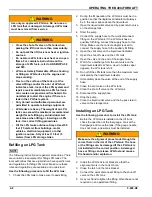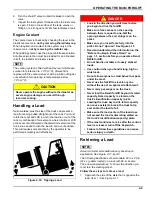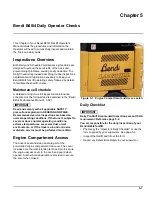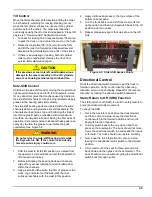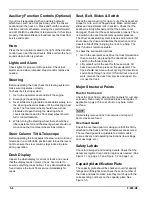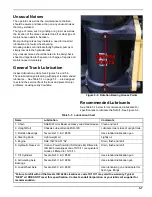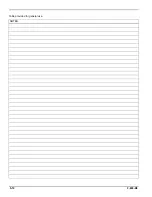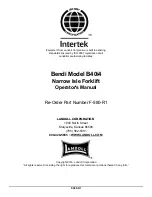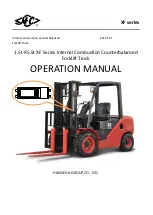
5-3
Tires and Wheels
The condition of the tires is to be checked along with the
lug nut torque setting at the beginning of each shift.
The truck is equipped with tires of a size and hardness
that provide the necessary traction and still maintain a
proper shape to minimize tipping. To maintain stability
and maximum reliability you must always replace tires
with the type originally supplied, as listed on the
specification sheet at the end of this manual. It is also
recommended to replace worn tires in pairs. Treaded
drive tires must be replaced when the tread depth is less
than 0.0625” (1.6mm) at the deepest point.
1.
Inspect the tire for chunking or embedded objects.
See Figure 5-2. This is caused by running over
objects on a littered floor, overloading or bad driving
habits - i.e. sharp, rapid turns at high speeds or rapid
starts and stops.
Figure 5-2: Tire Wear and Damage
• Remove any embedded foreign material and torn
pieces of tread as soon as it is noticed.
• Replace chunked tires if it produces a rough ride.
2.
Inspect tires for undercutting and uneven wear.
Undercutting is caused by continuous overloads,
rapid sharp turns, operating on slopes, a faulty steer
axle, transporting loads with a high center of gravity
or transporting off center loads causing the rubber to
bulge out over the edge of the steel band, cutting the
rubber just above the base band. Uneven tire wear is
usually the result of mechanical defects, such as
badly adjusted brakes, misaligned wheels or a faulty
drive axle.
3.
Check that the tires remain centered on the wheels to
prevent splitting of the base band and tread
separation. Correct defects as soon as possible.
4.
Flat spotting can occur from excessive heat, a load
left on the forks overnight, or locking the brakes with
excessive skidding.
5.
Avoid oil, grease, gasoline and acid.
6.
Torque lug nuts to 205 ft.-lbs. (275 Nm) and make
sure no lug nuts are missing.
IMPORTANT
If tires have excessive wear and/or chunking, or lug
nuts are missing, repair and/or have service replace
them immediately. Do not use the truck until repairs
are made.
Parking Brake
The parking brake system on an Bendi B40i4 forklift is
manually controlled and is a part of the brake pedal. See
Figure 1-3 on page 1-6.
To check the park brake:
1.
Sit on the driver’s seat and start the engine.
2.
Leave the parking brake lever engaged and attempt
drive forward at a very slow speed.
3.
The park brake should not allow the truck to move.
4.
If any problems are found with the operation of the
park brake immediately pull the truck from service,
repair and do not use the truck.
Accelerator Control
With the engine running and the direction control in the
forward position gradually press on the drive pedal. The
further you press on the drive pedal the faster the truck
will go. Let up on the drive pedal and the truck should
come to a controlled stop. Check to make sure the pedal
does not stick or catch. If the accelerator functions
incorrectly, remove truck from service immediately and
repair.
Lift Chains
Primary Lift Chain (Duplex, Triplex and
Quadplex Masts)
Visually inspect the chain for cracks, stretched or
stressed links and broken pins. When raising the mast
listen for usual chain noise and watch the action of the
chain for anything unusual. Watch for unusual pulley
movement or pulley wobble that would indicate a worn
mast bearing.
Summary of Contents for Bendi B40i4
Page 2: ......
Page 12: ...1 4 F 808 R0 FORKLIFT SAFETY AND FAMILIARITY Figure 1 2 Decals...
Page 18: ...1 10 F 808 R0 FORKLIFT SAFETY AND FAMILIARITY Table provided for general use NOTES...
Page 24: ...2 6 F 808 R0 RECEIVING AND INSPECTION Table provided for general use NOTES...
Page 54: ...4 16 F 808 R0 OPERATING THE B40I4 FORKLIFT Table provided for general use NOTES...
Page 62: ...5 8 F 808 R0 Figure 5 5 Lubrication Points...
Page 64: ...5 10 F 808 R0 Table provided for general use NOTES...




